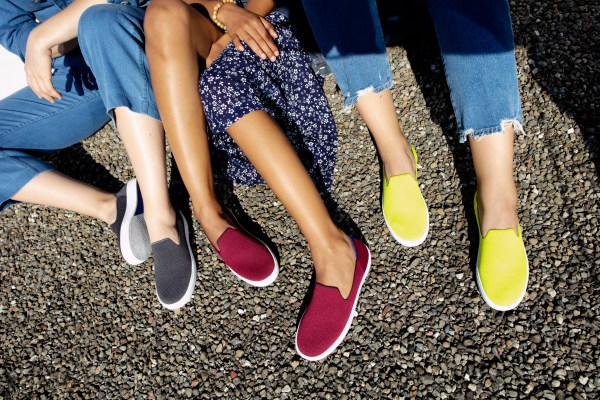If you are a woman who has used the internet to buy something, particularly if you are a woman who has used the internet to buy something in the Bay Area, there’s a very high likelihood you have seen ads for Rothy’s everywhere you go on social media, particularly Facebook. In fact, they’ve likely been following you for years. The reason: spending big on Facebook and, to a slightly lesser extent, Instagram, has paid off hugely for the three-year-old, San Francisco-based company, which makes shoes out of recycled materials.
Its signature product is its ballet shoe for women, which comes in two silhouettes — a rounded and a pointed-toe version — and 21 patterns. But like most e-commerce brands, Rothy’s hasn’t been content to stop with one apparently winning product. Instead, earlier this year, the company introduced a women’s loafer, followed by a line of shoes for girls ages five through12 that mirror its ballet shoe line for grown-ups.
Today, it’s extending its product line again, introducing what it calls a sneaker, though it’s really a sneaker in as much as Vans classic slip-on skateboarding shoes are sneakers. In short, they’re fun and colorful, but you probably don’t want to play basketball in them.
Last summer, to learn more, we’d talked with Rothy’s cofounders Roth Martin and Stephen Hawthornthwaite about the company, which has so far raised just $7 million in funding — all of which closed around the time of our conversation.
Yesterday, we chatted with a newer executive at the company, Kerry Whorton Cooper, who joined Rothy’s president earlier this year after working previously as the COO an CMO of ModCloth and as a VP at Walmart.com, among other roles. We asked if Rothy’s is raising another round any time soon. She also caught us up on what else is happening at the startup, which has now grown to 500 employees, including 450 who work out of the company’s own, 100,000-square-foot factory in Southern China.
TC: Rothy’s is a hot brand. Will we see another round close in 2018?
KC: We haven’t raised anything beyond that one institutional round that closed last summer. We’re profitable and cash-flow positive, unlike a lot of other [newer brands] so that hasn’t been an urgent issue, though it’s something we entertain as we think about what’s strategically important.
TC: How many shoes has Rothy’s sold?
KC: We don’t disclose that, but in May, we passed what we’d sold in all of 2017, and our sales in 2017 were probably 1,000 times the sales were generated in 2015. I think we clearly have product-market fit.
TC: You introduced some newer products earlier this year — a loafer and a kids’ line of shoes. Why?
KC: The durability and washability of our shoes appeals to a lot of people and to a lot of parents, some of whom especially enjoy the mommy-and-me look. The shoes are also easy to dress up and dress down, though it’s still a small part of our business.
TC: Are Rothy’s shoes still available exclusively through your website?
KC: We also opened a store on San Francisco’s Fillmore street in May, an old cobbler’s store that we restored.
TC: Is that the first step to more stores in more cities?
KC: There are obvious other markets like New York and Washington and Boston — heavy transit cities. There’s probably a little more opportunity as we think of more locations here (in California). But we want to be measured in how we approach this to ensure the retail strategy is sustainable.
TC: Rothy’s has its own factory in China but I assume you are past the point of making your shoes to order.
KC: We aren’t doing made to order. There are core colors that we always want to have in stock, and we’re pretty clear about just how much we need to make. When it comes to newer colors, we have a supply chain we can chase. We’ll launch some things on a Thursday and basically, by the next day, we can tell what the winners are. We also produce limited runs of shoes to surprise and delight people visiting the store. We’ve played with embroidery, for example.
TC: Why introduce slip-on sneakers, too?
KC: It’s kind of an iconic stye that we’ve been watching for a while but we wanted to wait to introduce to get the right fit and appearance first, especially because we don’t have laces to make the fit right. But these, too, are made from all recycled materials. They’re machine washable. They also have a foam wedge that provides more cushioning.
TC: Has Rothy’s marketing strategy changed at all? Judging by my Facebook feed, it has not.
KC: Social media continues to be a really important channel for us, though the largest channel is word of mouth. It’s a very distinctive-looking shoe, so people stop and ask people about them, which increases returns as more people wear them. But Facebook and Instagram are the biggest drivers. On Instagram, our customers send us more beautiful photography than we could do ourselves and we’ve leveraged that. We’ve also dabbled with influencers, though less at the Kardashian level and more around interesting women with interesting style who other women look up to.
